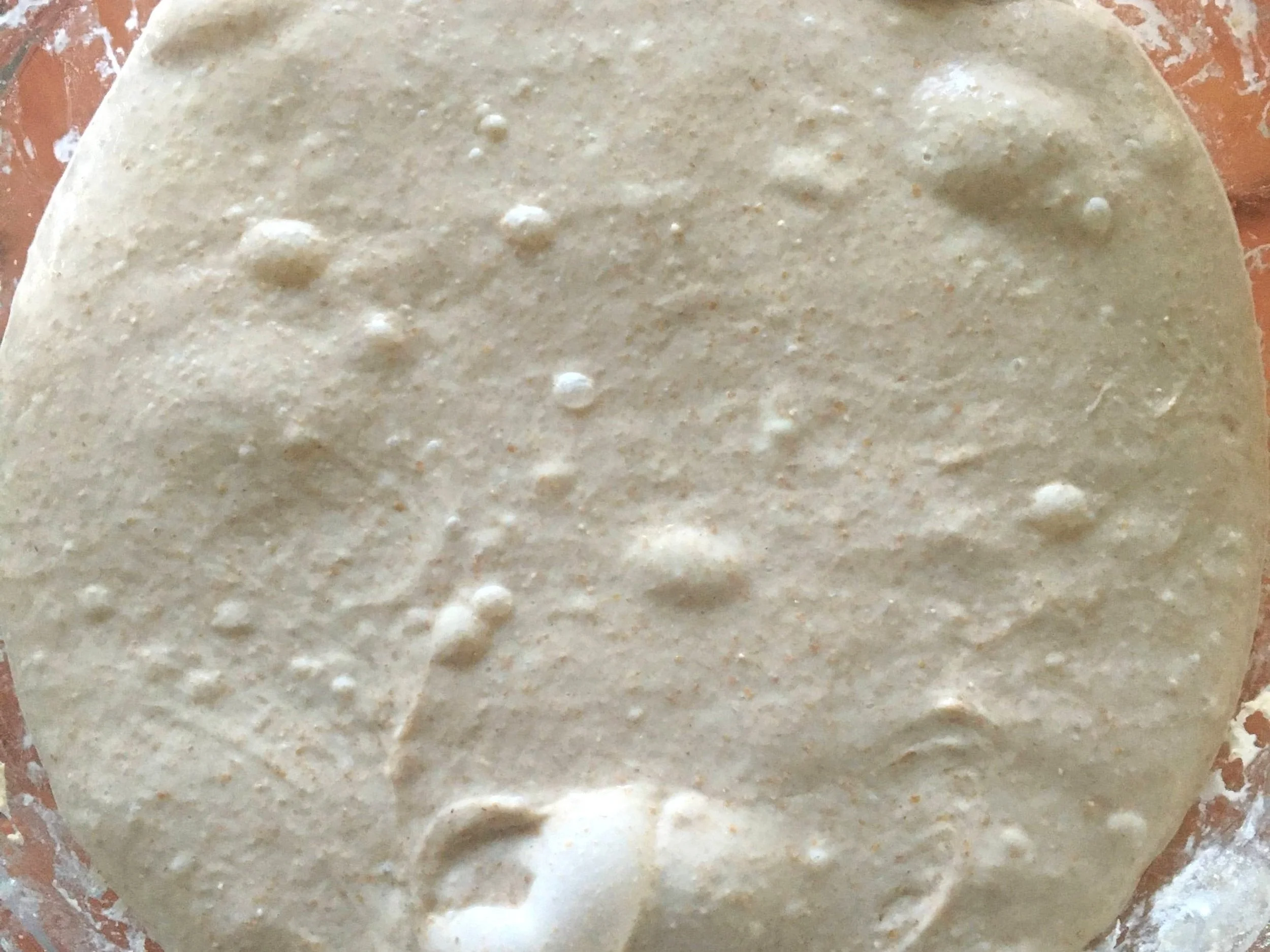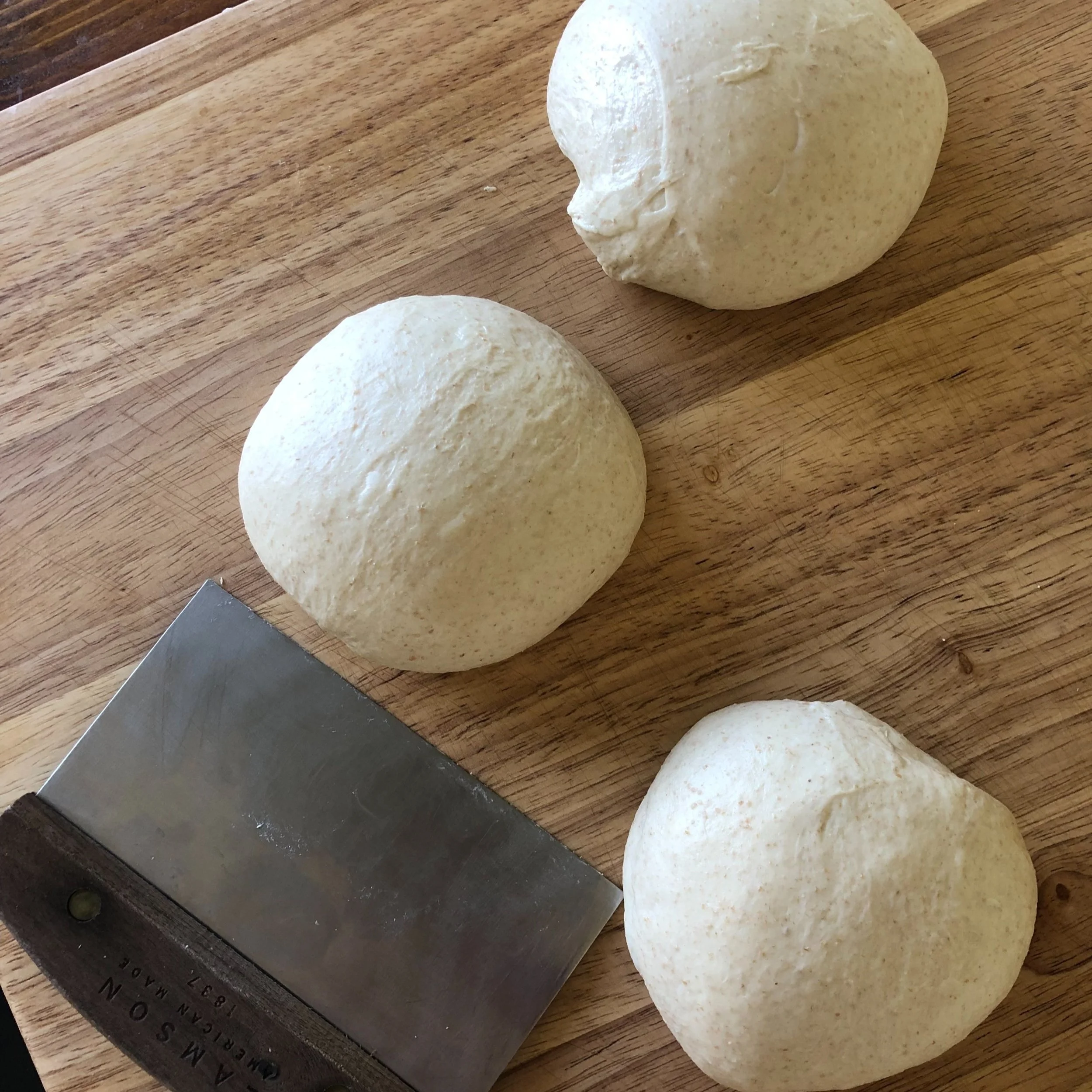Simple Sourdough
You’ll never buy bread at the store again!
As an Amazon Associate I earn from qualifying purchases.
Procedure
Equipment Used
Scale
Large mixing bowl (preferably one with a lid or you can use plastic wrap or a towel to cover when dough is resting)
Banneton basket (or proofing bowl with tea towel)
Lame (or serrated knife for scoring)
Bench scraper
Spray bottle
Click here for a full list of Essential Tools
Ingredients
Yields two smaller boules or one larger boule
400 grams (80%) Central Milling’s Organic Type 70 Malted bread flour
100 grams (20%) Central Milling’s Organic Whole Wheat Hi-Pro Fine
400 grams (80%) Water
75 grams (15%) Levain
10 grams (2%) Sea Salt
TOTAL FLOUR = 500 grams, TOTAL DOUGH WEIGHT = 985 grams
Plus rice flour for dusting work bench and banneton baskets
Adding weighed ingredients to mixing bowl
Process (Suggested timings)
Prepare Levain (7:00 am)
Feed levain 1:1:1 ratio at least 4-6 hours prior to mixing in bulk dough (see post on Maintaining a Starter). Time for a little math; if you want 75 grams of levain for the dough, you need to have at least 30 grams of starter, 30 grams water, 30 grams whole wheat flour for a total mixture of 90 grams. This allows you to save a small portion of the levain to continue maintaining your starter for the next bake.
Mix Ingredients (12:00 pm)
Add flours, salt, levain, and water in a large bowl and use your hand to mix the ingredients until there are no dry bits and the gluten starts to form creating a smooth, elastic mass. Mixing by hand usually takes 5 - 10 minutes. The fermentation timer starts as soon as the levain is added to the dough. Following initial mixing, cover your bowl and allow the dough to rest for about 15 minutes.
Build Gluten Strength (12:00 pm - 2:00 pm)
Use gentle coil folds or stretch and folds every 15 - 20 minutes following initial mixing to build dough strength during the first 2 hours of bulk fermentation. The quantity of folds depends on how elastic your dough is; the more the dough can stretch the more folding is needed to help build strength. Strength building is used so that the dough holds it’s shape, allowing the dough to rise upward instead of outward during baking. You know your dough is developed using the windowpane test. This is achieved by gently stretching a tablespoon size piece of dough until it is thin enough for light to pass through without tearing.
Bulk Ferment (2:00 pm - 4:00 pm)
Allow the dough to rest for 2-3 hours after completing folds. Check the dough once every hour to see how much it has risen and bubbled. You know it is ready to shape ONLY if dough has risen approximately 30% in volume and is showing bubbles after resting (approximately 4-5 hours from initial mixing, i.e. adding the levain; this also depends on the ambient temperature - warmer environments may cause this rise to happen in 3-4 hours, colder environments may cause the rise to happen in up to 6 hours).
Dough should look like this when it is near ready to divide and shape (approximately 4 - 6 hours after initial mix)
Divide and Shape (4:00 pm - 4:30 pm)
Mist the work surface and carefully turn dough out onto the surface.
Using a bench scraper gently divide the dough into two equal pieces; use the scale to weigh each piece to be approximately 445 grams.
Shape each piece with the help of the bench scraper into a round. Take care not to over handle or flip the dough while shaping as this can cause degassing and result in a flatter loaf (tighter crumb) once baked. Ideally, the dough would be shaped with minimal handling, which only comes with practice! Allow the dough to rest for about 15 minutes.
Using rice flour, lightly dust the top of the boules and the banneton baskets. Use the bench scraper to turn the dough onto the floured side and proceed to final shaping by pinching opposite sides, gently stretching and tucking into the center. Perform this method all the way around the edge of the dough, gently pulling the dough into the center to tighten the boule. Carefully roll the dough onto the seam side and tighten further if the dough can handle it. Allow the dough to rest and the seams to seal. Delicately lift the dough off the bench and ease it into the banneton basket - SEAM SIDE FACING UP! Cover the banneton baskets with the lining cloth or a plastic bag and place in the refrigerator overnight.
Retard (4:30 pm - 8:30 am NEXT DAY)
The dough will continue to ferment at a much slower rate in the refrigerator (retard).
Bench scraper with delicately shaped boules, resting before final shape
NEXT DAY Bake
Preheat the oven with baking stone or dutch oven on the middle rack to 500 degrees F. If using a baking stone the oven needs to be steamed. This is achieved by preheating an oven safe dish on the bottom rack and carefully putting a handful of ice cubes into the dish after loading the dough onto the baking stone. If using a dutch oven, the dough is steamed by placing the lid on the dutch oven for the first part of baking.
When the oven is preheated, remove the dough from the banneton baskets by turning the dough out onto parchment paper, seam side down; remove the banneton basket to reveal the top of the loaf. Using a lame or a serrated knife, score the loaf.
Transfer the scored dough with parchment paper into the dutch oven or baking stone, carefully and quickly steam the oven or cover dutch oven with lid and close the oven door. Bake for 20 - 25 minutes with steam. Then remove the dutch oven lid or baking dish with water from the oven and bake an additional 15 minutes or until desired color. These times are approximate and will vary depending on your oven.
Check the bottom of the loaf near the end of the bake to ensure golden color, this is a good indicator for being fully baked.
Transfer the bread from the oven to a cooling rack. Wait at least 2 hours before slicing! This allows the crumb to set and be easier to slice.
Final product with perfectly golden crust





